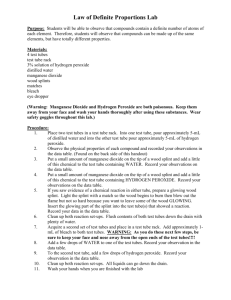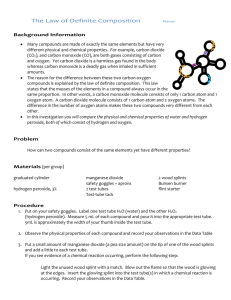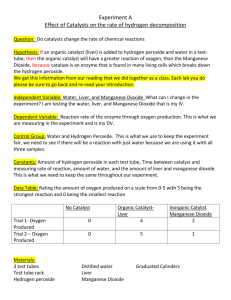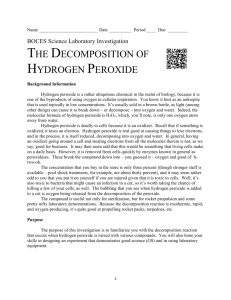Law of Definite Proportions Lab
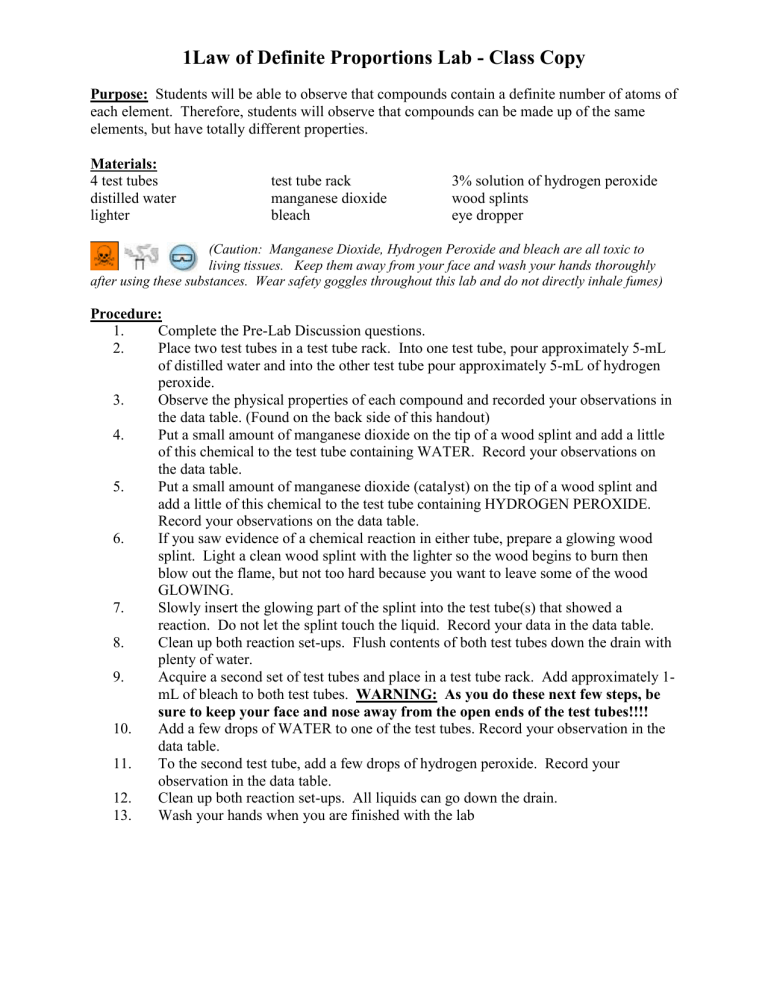
1Law of Definite Proportions Lab - Class Copy
Purpose: Students will be able to observe that compounds contain a definite number of atoms of each element. Therefore, students will observe that compounds can be made up of the same elements, but have totally different properties.
Materials:
4 test tubes distilled water lighter test tube rack manganese dioxide bleach
3% solution of hydrogen peroxide wood splints eye dropper
(Caution: Manganese Dioxide, Hydrogen Peroxide and bleach are all toxic to living tissues. Keep them away from your face and wash your hands thoroughly after using these substances. Wear safety goggles throughout this lab and do not directly inhale fumes)
Procedure:
1.
Complete the Pre-Lab Discussion questions.
2.
Place two test tubes in a test tube rack. Into one test tube, pour approximately 5-mL of distilled water and into the other test tube pour approximately 5-mL of hydrogen peroxide.
3.
Observe the physical properties of each compound and recorded your observations in the data table. (Found on the back side of this handout)
4.
Put a small amount of manganese dioxide on the tip of a wood splint and add a little of this chemical to the test tube containing WATER. Record your observations on the data table.
5.
Put a small amount of manganese dioxide (catalyst) on the tip of a wood splint and add a little of this chemical to the test tube containing HYDROGEN PEROXIDE.
Record your observations on the data table.
6.
If you saw evidence of a chemical reaction in either tube, prepare a glowing wood splint. Light a clean wood splint with the lighter so the wood begins to burn then blow out the flame, but not too hard because you want to leave some of the wood
GLOWING.
7.
Slowly insert the glowing part of the splint into the test tube(s) that showed a reaction. Do not let the splint touch the liquid. Record your data in the data table.
8.
Clean up both reaction set-ups. Flush contents of both test tubes down the drain with plenty of water.
9.
Acquire a second set of test tubes and place in a test tube rack. Add approximately 1mL of bleach to both test tubes. WARNING: As you do these next few steps, be sure to keep your face and nose away from the open ends of the test tubes!!!!
10.
Add a few drops of WATER to one of the test tubes. Record your observation in the data table.
11.
To the second test tube, add a few drops of hydrogen peroxide. Record your observation in the data table.
12.
Clean up both reaction set-ups. All liquids can go down the drain.
13.
Wash your hands when you are finished with the lab
Name _______________________________________________________ Period ______
Data Table 1: Reactions with Manganese Dioxide
Compound Physical Properties of the liquid compound
Chemical Properties (Evidence of a chemical reaction with
Manganese Dioxide)
Distilled Water (H
2
O)
Hydrogen Peroxide (H
2
O
2
)
Data Table 2: Reactions with Bleach
Reactants
Bleach and Water (H
2
O)
Observations:
Bleach and Hydrogen Peroxide (H
2
O
2
)
Conclusion Questions: Please use complete sentences.
1.
Compare the physical properties of water and hydrogen peroxide.
_____________________________________________________________________
_____________________________________________________________________
2.
Compare and contrast the molecular formulas of water and hydrogen peroxide.
_____________________________________________________________________
_____________________________________________________________________
3.
State a hypothesis to explain why water and hydrogen peroxide have different chemical properties.
_____________________________________________________________________
_____________________________________________________________________
4.
Hydrogen gas burns. Oxygen gas supports burning of other materials. Which gas do you think was produced?
_____________________________________________________________________
_____________________________________________________________________
5.
The atomic mass of hydrogen is 1.0 and the atomic mass of oxygen is 16.0. Calculate the ratio by mass of hydrogen to oxygen in water and in hydrogen peroxide.
(Mass of Hydrogen atoms compared to mass of oxygen atoms)
Water - H
2
O:
Hydrogen Peroxide - H
2
O
2
:
6.
How does The Law of Definite Proportions explain why water and hydrogen peroxide have different properties, although they consist of the same elements?
_____________________________________________________________________
_____________________________________________________________________
_____________________________________________________________________
_____________________________________________________________________
7.
Why do you think hydrogen peroxide and bleach reacted as they did?
_____________________________________________________________________
_____________________________________________________________________
_____________________________________________________________________
8.
How could you find out if bleach is used up in the reaction with hydrogen peroxide or if it is a catalyst?
_____________________________________________________________________
_____________________________________________________________________


